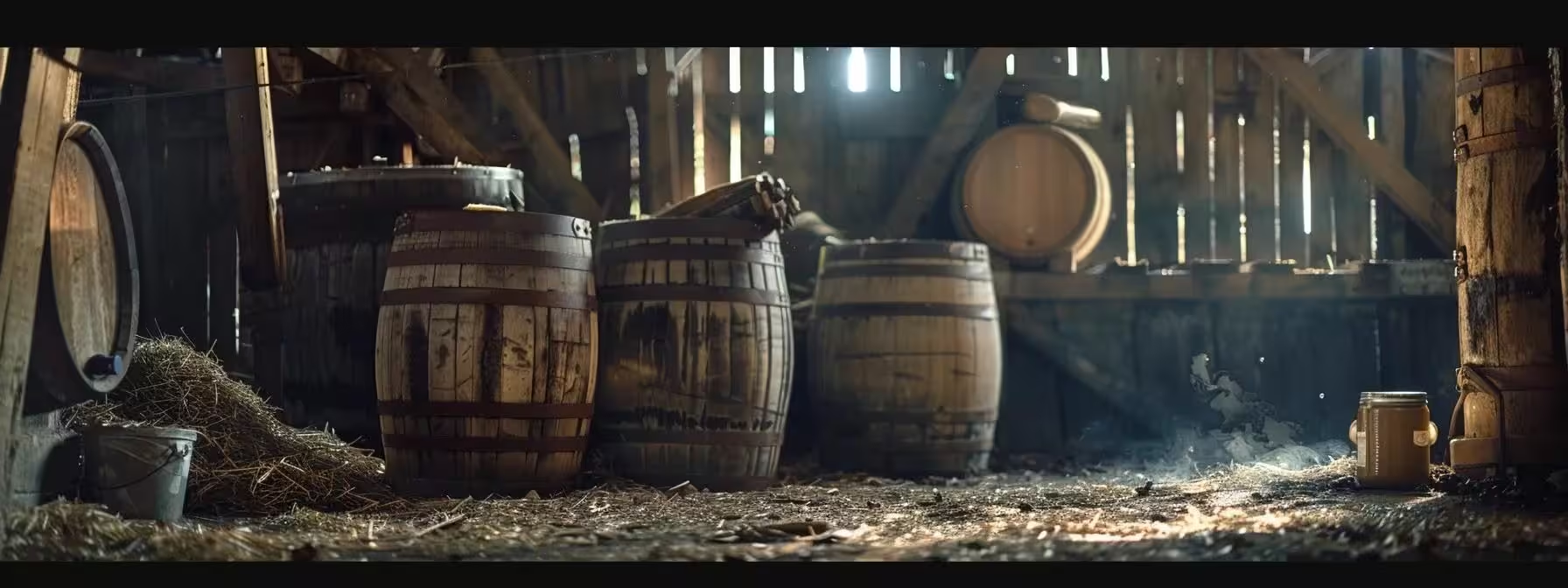
Welcome to the
art of
cider fermentation, a journey that starts in the
orchard and ends in the
glass. As a Brew Master, I find the transformation of simple apples into delectable
cider nothing short of magical. It’s a process where nature’s gifts – the
fruit‘s natural
sugar and the wild
bacteria of the environment – meet human ingenuity to create a bubbly delight. The core of this craft lies in guiding the
fermentation process, a delicate dance with
yeast that turns sugars into
alcohol. In this article, we’ll walk you through the essentials of crafting a robust
cider – from hand-picking the finest apples bursting with flavor to understanding the pivotal role of
yeast and nutrients. If you share my passion for brewing or are curious about making your own
cider, carry on with me to unveil the secrets behind every successful batch of homemade
cider.
Understanding the Core of Cider Fermentation
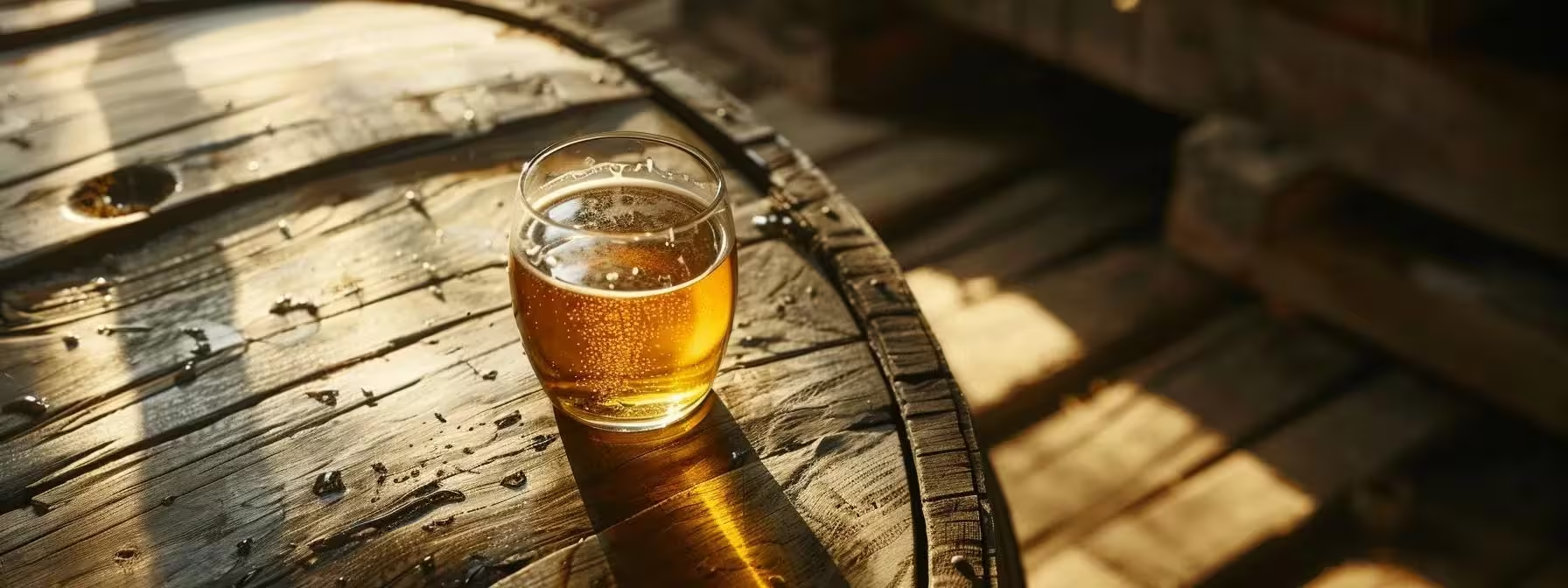
As someone with a passion for the craft of
cider making, I’ve come to recognize that the heart of a fine
cider lies in its
fermentation process.
Fermentation transforms simple
apple juice into a refreshing, complex beverage by the action of
yeast, which consumes the sugars in the
juice, producing
alcohol,
carbon dioxide, and a variety of flavors and aromas. Comparing
cider with other fermented drinks, like
beer and
wine, highlights distinctive processes tailored to each beverage’s unique characteristics.
Yeast selection not only influences the
cider‘s character but can also make or break the quality of the final product. Precision in monitoring and controlling the
fermentation journey is fundamental; from spotting issues early on to identifying the optimal point of completion. With
cider, the
alcohol content is not set in stone – it can be controlled throughout
fermentation, allowing for custom strengths and tastes. Then, considering the variety of apples used, we can expect specific
fermentation patterns, and acidity profiles that are as diverse as the apple types themselves. Lastly, additional ingredients we might choose to introduce, such as fruits or spices, can significantly steer the
fermentation roadmap, culminating in a unique
cider experience. Each of these facets are essential threads in the tapestry of
cider fermentation, and delving into them will surely enrich any brewer’s expertise.
What Is Fermentation and Its Role in Cider Making?
Fermentation, in essence, is a biological process during which
yeast converts the sugars present in
apple juice into
ethanol and
carbon dioxide, giving
cider its distinctive alcoholic content. This transformation not only forms the basis for the
alcohol by volume (ABV) in the
drink but also develops a broad spectrum of flavor compounds, setting the foundation for a
cider‘s uniqueness when compared to
wine or other fermented beverages.
In my experience as a brew master, I’ve observed that the careful management of
fermentation is what allows a simple apple-based
mixture to mature into an extraordinary
cider. It is a delicate balance where controlling temperature,
yeast strains, and
oxygen exposure ensures the
cider develops the desired
taste and quality, resulting in a beverage that can hold its own alongside any distinguished
wine.
Comparing Fermentation Processes in Cider, Beer, and Wine
The
cider fermentation process shares fundamentals with
beer and
wine production, yet it carries its own distinct nuances. In brewing
beer, the
alcohol content and
taste heavily rely on the grains used and the intricate balance of hops, whereas
wine‘s flavor and structure are influenced by
grape variety and
tannin profiles.
Cider‘s
alcohol level and
taste, by contrast, hinge on the apple types and the
fermentation‘s progression, controlled to retain or reduce the level of natural
sweetness.
Although all three beverages undergo
fermentation, the presence of tannins in
wine creates a different texture, and the use of hops in
beer introduces varied bitterness and aroma profiles not typically found in
cider. Additionally, the
carbon dioxide produced during the
cider fermentation process is often retained to achieve that desired sparkle, a characteristic sometimes moderated in
beer and seldom seen in still wines. The intermediary role of
cider, with its
fruit origins and preference for freshness, sets it apart in the
fermentation family.
The Crucial Impact of Yeast Selection on Cider Quality
When brewing
apple cider, selecting the right
yeast becomes a pivotal choice. This
microorganism is what differentiates a flat, uninspiring concoction from an aromatic, flavorful
alcoholic beverage. Unlike
beer, where the grains and hops play leading roles, in
apple cider, the
yeast determines the complexity and crispness of the finished product.
The
water quality and
yeast strain directly influence
cider’s
taste and clarity. In crafting this delightful beverage, I ensure the
water is pure and complemented with a
yeast that can flourish, bringing out the subtle nuances of the apples. This attention to detail is what elevates a good
cider to a great one, showcasing my dedication to exemplary
cider brewing.
Identifying and Troubleshooting Common Fermentation Issues
Assessing the progress of
fermentation requires precision, and the use of a
hydrometer helps to gauge the
density of the
cider compared to
water. If the measurements indicate a sudden halt in
fermentation or unexpected
sweetness levels, it may signal an issue such as stalled
yeast activity or an incomplete
fermentation process. Solutions might include examining the
airlock for potential obstructions or contemplating a second stage of
yeast introduction to conclude the
fermentation.
In cases where the desired level of
sweetness is achieved, yet
fermentation continues, risking the
cider‘s balance,
pasteurization becomes a viable option to halt
yeast activity. For
cider varieties that incorporate
pear, achieving an ideal balance of
sweetness and
alcohol can be particularly challenging. A careful watch is required to prevent over-
fermentation, which can strip away the intricate flavors and
sweetness distinctive to
pear ciders.
Monitoring Fermentation Progress and Deciding Its Completion
As a brew master, I pay close attention to the
nutrient levels throughout the
fermentation process, ensuring that the
yeast has the necessary components to thrive and complete its task. My eyes are always on the subtle changes in specific
gravity, carefully deciding when the process has reached its peak. Knowing just the right moment to halt
fermentation requires experience and a keen sense of the
cider‘s evolving
taste and aroma.
Another aspect I carefully manage is the possibility of
malolactic fermentation, which can soften the tartness in ciders high in
malic acid. By controlling the temperature and deciding whether to introduce specific
bacteria, I can guide the transformation of
malic acid into the smoother
lactic acid. If the
cider is ready, I’ll gently
siphon it from the
sediment, applying a touch of
heat if necessary, to prepare it for maturation, all while preserving its delicate and crafted flavor profile.
Controlling Alcohol Content During the Cider Fermentation Process
In my years of crafting
cider, I’ve learned that maintaining the perfect
alcohol level is akin to conducting a symphony; each element must come together harmoniously. By consistently measuring the
sugar content in the fermenting
juice within a
carboy or
barrel, I can predict the potential
alcohol yield. Controlling variables like temperature prevents unwelcome outcomes such as too much
lactic acid or, worse,
vinegar, ensuring the final product is always up to the standard my customers expect.
During
fermentation, I also monitor the clarity of the
cider, as substances like
pectin can impact both the look and the feel of the
drink. Achieving the ideal balance between just enough natural
sweetness and the preferred
alcohol content without compromising the
cider‘s body is a subtle
art. Careful adjustments and timely interventions allow me to prevent any excess conversion into undesirable components, ensuring that each batch has the right
taste and punch.
The Effect of Different Apple Varieties on Fermentation Characteristics
Choosing the right type of
cider apple plays a significant role in the
fermentation profile and ultimately affects the drinker’s experience from the very first sip. With
saccharomyces cerevisiae, a commonly used
yeast in
cider making, certain apple varieties rich in sugars can lead to a higher final
alcohol content, which is measured by changes in
gravity during
fermentation. This is why I constantly test and refine to find the ideal balance that complements the symphony of flavors present in the
glass.
Handling the
pomace, which is the solid remains of apples after
pressing, also demands my attention, as it influences both the texture and the clarity of the
cider. Apples with a high
tannin content result in a more robust and complex
cider, presenting a challenge to maintain clarity without losing the essence that these unique varieties impart. Through meticulous process control, I can harness these characteristics to craft a
cider that truly honors the
fruit‘s origin.
How Additional Ingredients Influence the Fermentation Process
Introducing additional ingredients to
cider can significantly alter the
fermentation process, bringing with it shifts in
pH that can affect the
yeast‘s performance. For instance, if I add fruits with a higher acidity, such as cranberries or blackberries, this can lower the
pH of the
liquid, creating a sharper
taste profile while impacting the microbial stability of the
cider.
In my practice, I’ve learned to closely observe the interplay between
oxygen levels and the formation of
lees – the
sediment consisting of dead
yeast and other particles that settle during
fermentation. Be it adding extra
honey or
sugar to increase
alcohol content or
sulfur to preserve freshness, each additive can change how much
oxygen the
cider absorbs, influencing the texture and clarity of the finished product.
Selecting the Perfect Apples for Your Cider

As a
cider aficionado, I am acutely aware that selecting the right apple is critical for influencing the
fermentation process and defining the
cider‘s ultimate flavor profile. Each apple variety brings its unique level of
glucose and natural sugars to the brew, acting as the primary source of fuel for
yeast during
fermentation. Some varieties lend a tart edge, akin to a
spice subtly infused, while others might serve as a
sugar substitute, offering a softer, sweeter note. These choices directly
mold the
cider‘s character, building complexity or simplicity in flavor. When seasonality ushers in fresh harvests, it’s my cue to seek out the most flavorful apples, bearing in mind that their
sugar content and acidity will dictate the
fermentation‘s vigor and duration. This ensures a palate-pleasing balance in every sip. Even the
sediment at the bottom of the fermenting vessel can whisper secrets about the apples used — it’s a narrative of the
fermentation journey. And of course, the use of a
campden tablet can safeguard against any unwanted microorganisms, allowing the true essence of the chosen apples to flourish, unmatched and pure. In this craft, every tiny detail, from the apple’s
harvest season to the chemistry behind
fermentation, intertwines to create the harmonious
drink we call
cider.
The Importance of Apple Variety in Fermentation
The apple varieties chosen for
cider production are crucial because each kind imparts distinct
sugar levels and
enzyme compositions that influence
fermentation. For instance, apples with high levels of specific enzymes can expedite the breakdown of
pectin, leading to a clearer
cider without the need for additives like
sulfur dioxide, which is often used to control microbial growth pre-
fermentation.
In my craft, I’ve observed that the apple’s natural sugars play an integral role in determining the
cider‘s final
alcohol content, especially when working with
yeast strains with high fermentative power, akin to
champagne yeast. Such strains can convert more
sugar into
alcohol, which must be carefully monitored to ensure the final product maintains the desired
taste profile and is suitable for bottling without running the
risk of over-carbonation or
bottle burst.
How Different Apples Impact Cider‘s Flavor Profile
In the alchemy of
cider brewing, each type of apple is akin to a unique
spice, profoundly influencing the concoction that awaits. For example, apples high in
honey-like
sweetness can impart a full body and rich flavor, laying the groundwork for a robust
taste profile; meanwhile, apples with higher acidity can create a lively, tart palate that adds complexity and zest to the finished brew.
I take great care in preventing the taint of
contamination by ensuring that sulfites are managed accurately, safeguarding the purity of each batch. This requires a keen understanding of the interaction between sulfites and
yeast assimilable
nitrogen, which nourishes the
yeast cells, fostering a clean and desirable
fermentation that highlights the intrinsic qualities of the apples selected for the
cider.
Seasonal Considerations in Apple Selection for Cider Making
Timing is everything in the
art of
cider making, and understanding the seasons is crucial when selecting apples. For instance, late-season varieties are often at the peak of their
sugar content, which can influence the
density of the fermented
cider. With meticulous timing, I can sidestep overproduction of
acetic acid that occurs when fermentations drag on, which would otherwise give the
cider an unwelcome vinegary
taste.
As harvests cycle through the year, I keep a vigilant eye on the subtle shifts in acidity and
sugar levels in the apples, which plays a part in managing the
risk of
plastic off-flavors caused by compounds such as
acetaldehyde. Likewise, with the seasonal influx of wild
lactic acid bacteria, it’s imperative to balance these naturally occurring elements to retain the
cider’s intended flavor profile without the need for excessive intervention.
Preparing Your Apples for Fermentation

Getting your apples ready for
fermentation is a pivotal step in the
cider-making process. Proper cleaning removes unwanted
bacteria and wild yeasts, ensuring a clean canvas for your chosen
yeast culture. I prefer using a gentle wash with a
solution that includes
citric acid, which helps in preserving the
fruit‘s natural flavors and acts as a mild
preservative. When crushed, apples release their precious juices; it’s a process that’s both
art and science. You aim for a balance, extracting the most
juice while maintaining the integrity of the flavor compounds. Maceration also plays a key role, allowing the
fruit to sit and soften can enhance the depth and profile of your
cider‘s
taste, essentially priming the juices for an effective
fermentation. In this phase, patience is a virtue, as the longer the apples macerate, the more pronounced the flavors become. From here, I’ll be
racking off the clear
juice away from the solids, contemplating the use of additives like
potassium sorbate to stave off any unwanted
fermentation in sweeter ciders, like
perry, ensuring that every nuance of flavor we’ve worked so hard to develop carries through to the final, savored sip.
Cleaning and Crushing Techniques for Optimal Juice Extraction
To extract the highest quality
juice rich in
fructose, the natural
sugar essential for
fermentation, it’s vital to thoroughly clean the apples. This step involves removing debris and wild yeasts that could interfere with the
saccharomyces, our chosen
yeast for
fermentation. A meticulous cleaning routine prior to crushing ensures that the
fermentation process will promote the development of desired esters that contribute to the aroma and flavor profile of the
cider.
Once the apples are spotless, the next step in
homebrewing cider is the crushing process, which liberates the
juice from the
fruit. Utilizing a crusher or press with care not to damage the seeds, which can release bitterness, we aid the
saccharomyces in converting the
fructose into
alcohol. For an even clearer
cider, I sometimes introduce a
pectinase enzyme to break down the
pectin, thus ensuring a smoother
fermentation and a more polished final product.
The Role of Maceration in Enhancing Cider Flavors
During maceration, the hydraulic
pressure from the
fruit‘s own weight begins to
concentrate flavors and sugars, such as
sucrose, in the
pulp. This slow, patient urging out of
juice makes an intricate difference later when the
cider ferments, marrying the concentrated essence of the
fruit with each added
ingredient for a deep, harmonious flavor profile.
Introducing
potassium metabisulfite in this early stage is a maneuver I often consider, ensuring that unwanted microbes don’t spoil the profile we’ve labored to refine. As the macerated apple
mixture transitions to the
keg, this forethought helps stabilize the
cider, safeguarding each nuanced
taste that maceration so expertly develops.
The Significance of Yeast and Nutrients in Cider Making
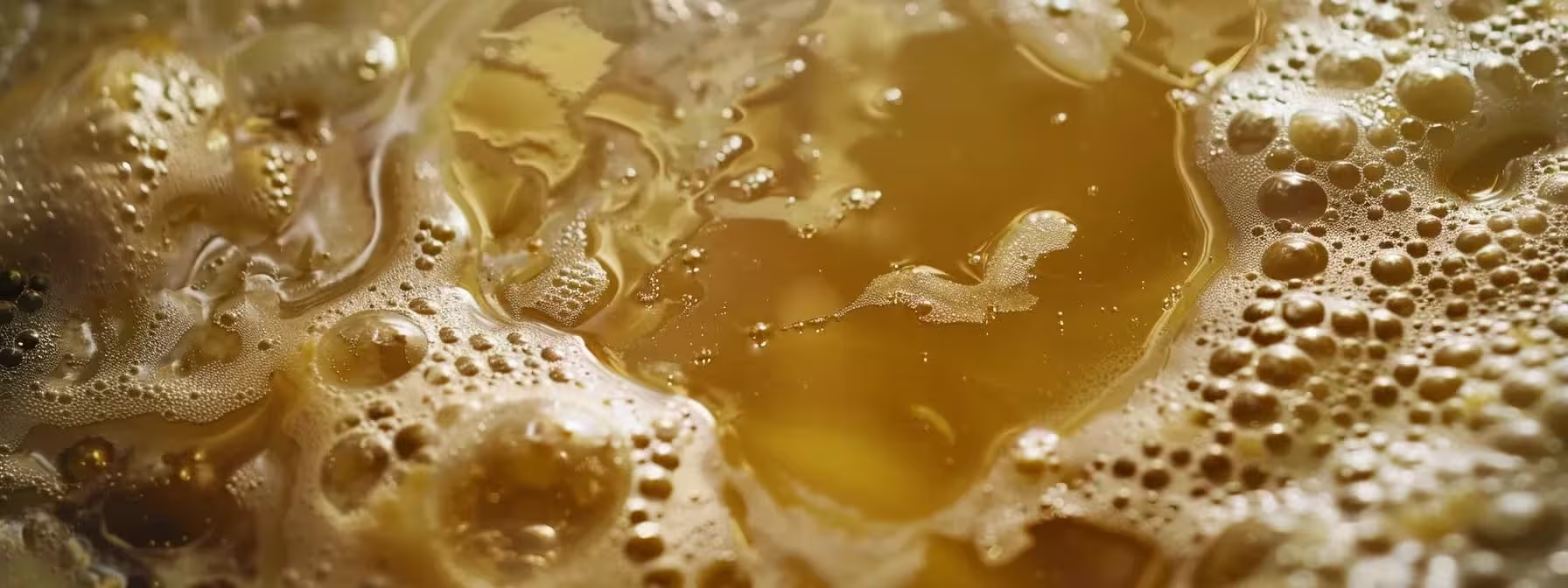
In the world of
cider brewing, as any seasoned
winemaker knows, the choice of
yeast can profoundly influence the
drink‘s essence.
Yeast, a seemingly modest
fungus, is in truth a powerhouse that can determine a
cider‘s complexity and depth of flavor—it’s a decision as critical as selecting the perfect
grape for a fine
wine. With various strains offering different
fermentation characteristics, the right selection can complement the natural
sweetness of the apples, akin to the way a
mill carefully crafts the
sugar into
syrup. Beyond
yeast selection, the addition of nutrients plays an equally vital role. These nutrients feed the
yeast, ensuring a vigorous and healthy
fermentation process. Together, a judicious choice of
yeast and well-timed
nutrient additions lay down the foundation for a
cider that transcends the ordinary, offering a
taste experience steeped in tradition yet refined by modern understanding.
Choosing the Right Yeast Strain for Your Cider
Choosing the right
yeast strain for
cider can sometimes feel as important as selecting the finest apples from
France‘s renowned orchards. A well-chosen
yeast not only drives
fermentation but also imparts unique flavor profiles. For example, using a
strain such as
oenococcus oeni, often employed in winemaking, can lend a subtle complexity to the
cider, while at the same time aiding in
malolactic fermentation which smoothens out acidity.
Meanwhile, keeping the
fermentation process under control may require stashing the fermenting
cider in a
refrigerator to slow the activity of the
yeast. This
organism, while central to transforming
apple juice into the splendid beverage we adore, may require such interventions; chilling the environment acts as a
solution to prevent it from overworking, thus maintaining the
cider‘s intended character and preventing undesirable flavors.
Nutrient Additions to Support Healthy Fermentation
Adding
nutrition to the
cider during
fermentation is a strategy I employ to ensure the
yeast remains active and healthy. The introduction of
sorbic acid, typically at the rate of a few grams per
gallon, acts as a
preservative, preventing
yeast from reproducing further once I deem the
cider‘s
alcohol and flavor profile perfect. This way, the
cider retains its desired
taste and stays stable for a longer time.
I also incorporate sources of
amino acid into the mix, a crucial element in
yeast nutrition that arms the
yeast cells with the building blocks necessary for protein synthesis. Sometimes a modest dose of
brown sugar not only adds a slight depth to the flavor but also provides an extra kick of
energy for the
yeast, enabling a strong and sustained
fermentation process.
Beyond Apples: Exploring Fruit and Spiced Ciders
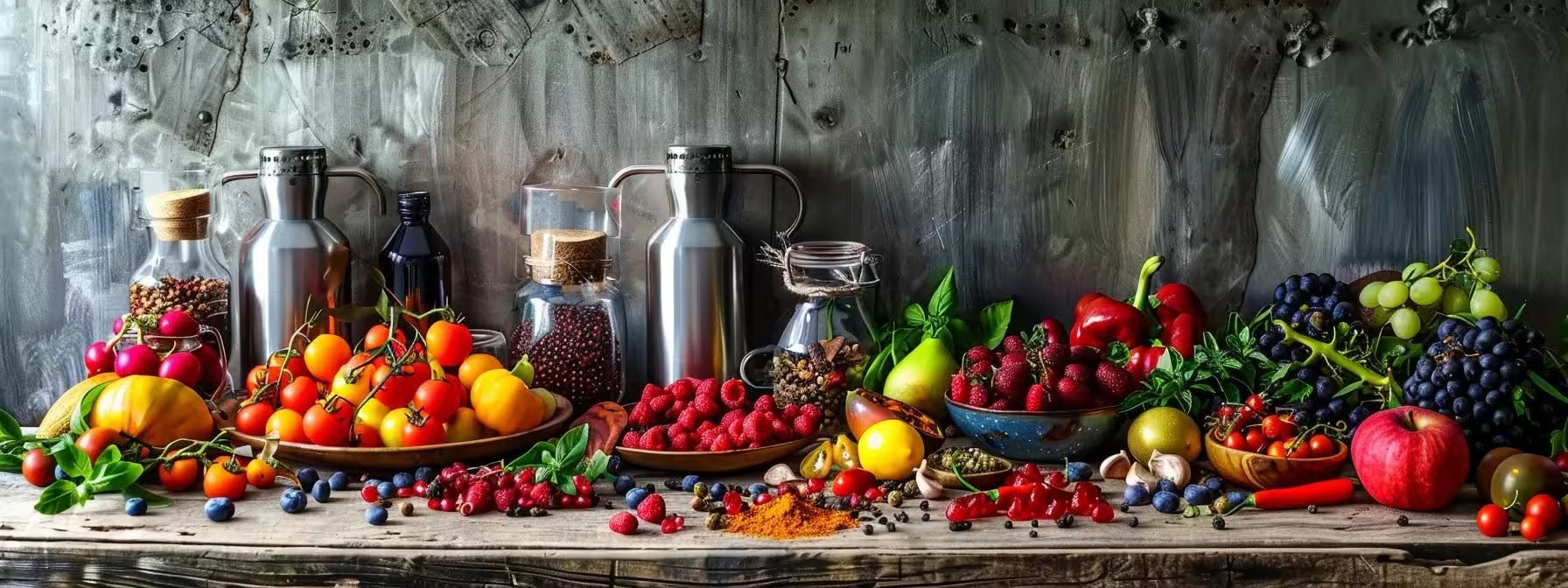
Branching out from traditional apple ciders, the adventurous brewer can embrace an array of possibilities by incorporating other fruits into the
fermentation process. Varieties like pears, cherries, and raspberries enhance the original
wort with distinct nuances and a bold, exciting profile. These fruits, when included with careful consideration to balance, can coexist with the apple base to create a fusion of tastes. I pay close attention to risks such as the introduction of wild yeasts like
brettanomyces, which can produce unexpected and sometimes undesirable flavors. To control such variables, I often turn to
stainless steel fermenters which offer a clean and manageable environment for the
cider to develop. When adding spices and herbs, the
skin of added fruits brings a
risk of harboring unwanted
bacteria, therefore, timing and method of infusion are key to imparting those unique flavor profiles safely. By monitoring each step with precision and maintaining an open mind to the wealth of flavors nature provides, I craft ciders that not only reflect tradition but also showcase innovation.
Incorporating Other Fruits Into Cider Fermentation
Experimenting with the addition of different fruits into
cider fermentation can lead to exciting variations like
mead, which is traditionally made with
honey but can also incorporate fruits for added depth. When I introduce new fruits, I rely on
stainless steel tanks that provide a pristine environment for
fermentation, ensuring the
cider‘s quality remains uncompromised.
Using the right equipment is key to successfully blending other fruits into the
cider mix. A sterilized
steel pump allows for a smooth transfer while minimizing
contamination risks, and a wide-mouthed
funnel ensures even the bulkiest
fruit pieces from the
tree enter the
fermentation vessel cleanly and without hassle. This meticulous process is essential for capturing the essence of each
fruit in the final
cider flavor profile.
Adding Spices and Herbs for Unique Flavor Profiles
When I decide to enhance my ciders with spices and herbs, I think of them much like chefs think of seasonings – a strategic addition that can transform the
metabolism of the
fermentation process. Cinnamon sticks, vanilla pods, or peppercorns, introduced at the right moment, infuse the brew with complexity and can influence the clarity by contributing or reducing
haze depending on their oil content and interaction with the apple base.
Adding spices isn’t just about flavor; it’s also about tapping into
health-conscious trends. Patrons at my pub often inquire about the benefits they’ve read on
PubMed Central regarding
apple cider vinegar. To meet this interest, I consider how the antimicrobial properties of certain spices could mirror those
health advantages, while simultaneously working to maintain a clear,
haze-free
cider that appeals to both the palate and the wellbeing of my customers.
Finishing Touches: Enhancing Cider Post-Fermentation
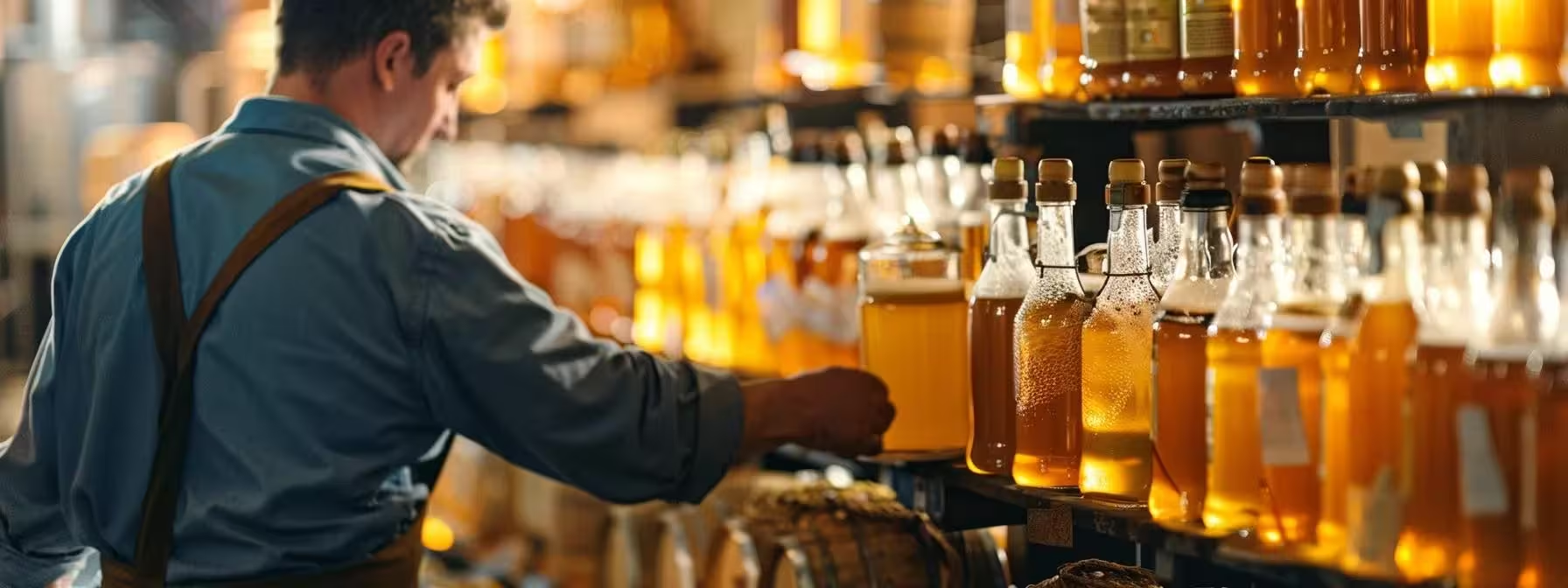
After the primary stages of
cider making, from selecting the right apples to overseeing the delicate balance of the
fermentation process through to completion, we arrive at a crucial juncture where the artistry of the
cider maker truly shines. This is the moment when we consider the
pulp that has served its purpose, remove the
stopper from our fermenting vessels, and step into the realm of refinement. With the aid of a
fruit press or the venerable
cider mill, the process of blending different batches invites complexity and balance, weaving individual character into every
bottle. It’s not just about the initial
fermentation but also about the intricate adjustments of
sweetness and carbonation before bottling that determine the
cider’s final profile.
Knowledge gleaned from reputable sources, including
PubMed, guides my decisions in this phase, ensuring the finished product is not only pleasurable to the palate but also remains true to the craft of
cider making.
The Art of Blending Cider for Complexity and Balance
Blending represents an
art form that’s integral to the character of final
cider offerings. Much like a baker intuitively knows just the right moment to pull
bread from the oven, I leverage the varied expressions of each
harvest, judiciously combining ciders to achieve a balance of flavors that might not be realized in a single batch alone. Strategically, a
teaspoon of one
cider‘s richness can smooth another’s sharpness, weaving a complex tapestry that delights the senses.
Throughout my career, I’ve found that the subtlety of
diacetyl, which often lurks in the profile of robust, buttery ciders, can be masterfully managed through the blending process. By adjusting proportions and pairing complementary flavor profiles, I can temper the
diacetyl presence or marry it to an apple variety with a brighter acidity, crafting a well-balanced
cider with a sophisticated finish. This delicate dance of flavors encapsulates the
art of
cider making.
Adjusting Sweetness and Carbonation Before Bottling
Upon concluding the
pressing and initial
fermentation, my focus shifts to the
cider‘s equilibrium, considering the presence of various
species of yeasts and their byproducts. The introduction of
tartaric acid, in measured amounts, can precisely adjust the tartness, thereby contributing to a well-rounded flavor profile.
Gleaning
information from earlier
fermentation stages, I assess the amines and other compounds that influence
taste, ensuring any adjustments complement the
cider‘s innate characteristics. This precise calibration of
sweetness, counterbalanced with appropriate carbonation levels, is critical before bottling to achieve the desired
mouthfeel and effervescence.
Conclusion
Mastering the basics of
cider fermentation is paramount for crafting a beverage with the desired balance of
alcohol,
sweetness, and complexity. Selecting the appropriate
yeast strain is essential, as it dictates the flavor and quality of the
cider, akin to the role spices play in cooking. Monitoring and adjusting the
fermentation environment ensures the
yeast performs optimally, creating a well-rounded and flavorful
drink. Finally, careful handling of the apple varieties and additional ingredients allows for a bespoke
cider that reflects both tradition and the individual skill of the brewer.
 Welcome to the art of cider fermentation, a journey that starts in the orchard and ends in the glass. As a Brew Master, I find the transformation of simple apples into delectable cider nothing short of magical. It’s a process where nature’s gifts – the fruit‘s natural sugar and the wild bacteria of the environment – meet human ingenuity to create a bubbly delight. The core of this craft lies in guiding the fermentation process, a delicate dance with yeast that turns sugars into alcohol. In this article, we’ll walk you through the essentials of crafting a robust cider – from hand-picking the finest apples bursting with flavor to understanding the pivotal role of yeast and nutrients. If you share my passion for brewing or are curious about making your own cider, carry on with me to unveil the secrets behind every successful batch of homemade cider.
Welcome to the art of cider fermentation, a journey that starts in the orchard and ends in the glass. As a Brew Master, I find the transformation of simple apples into delectable cider nothing short of magical. It’s a process where nature’s gifts – the fruit‘s natural sugar and the wild bacteria of the environment – meet human ingenuity to create a bubbly delight. The core of this craft lies in guiding the fermentation process, a delicate dance with yeast that turns sugars into alcohol. In this article, we’ll walk you through the essentials of crafting a robust cider – from hand-picking the finest apples bursting with flavor to understanding the pivotal role of yeast and nutrients. If you share my passion for brewing or are curious about making your own cider, carry on with me to unveil the secrets behind every successful batch of homemade cider.
 As someone with a passion for the craft of cider making, I’ve come to recognize that the heart of a fine cider lies in its fermentation process. Fermentation transforms simple apple juice into a refreshing, complex beverage by the action of yeast, which consumes the sugars in the juice, producing alcohol, carbon dioxide, and a variety of flavors and aromas. Comparing cider with other fermented drinks, like beer and wine, highlights distinctive processes tailored to each beverage’s unique characteristics. Yeast selection not only influences the cider‘s character but can also make or break the quality of the final product. Precision in monitoring and controlling the fermentation journey is fundamental; from spotting issues early on to identifying the optimal point of completion. With cider, the alcohol content is not set in stone – it can be controlled throughout fermentation, allowing for custom strengths and tastes. Then, considering the variety of apples used, we can expect specific fermentation patterns, and acidity profiles that are as diverse as the apple types themselves. Lastly, additional ingredients we might choose to introduce, such as fruits or spices, can significantly steer the fermentation roadmap, culminating in a unique cider experience. Each of these facets are essential threads in the tapestry of cider fermentation, and delving into them will surely enrich any brewer’s expertise.
As someone with a passion for the craft of cider making, I’ve come to recognize that the heart of a fine cider lies in its fermentation process. Fermentation transforms simple apple juice into a refreshing, complex beverage by the action of yeast, which consumes the sugars in the juice, producing alcohol, carbon dioxide, and a variety of flavors and aromas. Comparing cider with other fermented drinks, like beer and wine, highlights distinctive processes tailored to each beverage’s unique characteristics. Yeast selection not only influences the cider‘s character but can also make or break the quality of the final product. Precision in monitoring and controlling the fermentation journey is fundamental; from spotting issues early on to identifying the optimal point of completion. With cider, the alcohol content is not set in stone – it can be controlled throughout fermentation, allowing for custom strengths and tastes. Then, considering the variety of apples used, we can expect specific fermentation patterns, and acidity profiles that are as diverse as the apple types themselves. Lastly, additional ingredients we might choose to introduce, such as fruits or spices, can significantly steer the fermentation roadmap, culminating in a unique cider experience. Each of these facets are essential threads in the tapestry of cider fermentation, and delving into them will surely enrich any brewer’s expertise.
 As a cider aficionado, I am acutely aware that selecting the right apple is critical for influencing the fermentation process and defining the cider‘s ultimate flavor profile. Each apple variety brings its unique level of glucose and natural sugars to the brew, acting as the primary source of fuel for yeast during fermentation. Some varieties lend a tart edge, akin to a spice subtly infused, while others might serve as a sugar substitute, offering a softer, sweeter note. These choices directly mold the cider‘s character, building complexity or simplicity in flavor. When seasonality ushers in fresh harvests, it’s my cue to seek out the most flavorful apples, bearing in mind that their sugar content and acidity will dictate the fermentation‘s vigor and duration. This ensures a palate-pleasing balance in every sip. Even the sediment at the bottom of the fermenting vessel can whisper secrets about the apples used — it’s a narrative of the fermentation journey. And of course, the use of a campden tablet can safeguard against any unwanted microorganisms, allowing the true essence of the chosen apples to flourish, unmatched and pure. In this craft, every tiny detail, from the apple’s harvest season to the chemistry behind fermentation, intertwines to create the harmonious drink we call cider.
As a cider aficionado, I am acutely aware that selecting the right apple is critical for influencing the fermentation process and defining the cider‘s ultimate flavor profile. Each apple variety brings its unique level of glucose and natural sugars to the brew, acting as the primary source of fuel for yeast during fermentation. Some varieties lend a tart edge, akin to a spice subtly infused, while others might serve as a sugar substitute, offering a softer, sweeter note. These choices directly mold the cider‘s character, building complexity or simplicity in flavor. When seasonality ushers in fresh harvests, it’s my cue to seek out the most flavorful apples, bearing in mind that their sugar content and acidity will dictate the fermentation‘s vigor and duration. This ensures a palate-pleasing balance in every sip. Even the sediment at the bottom of the fermenting vessel can whisper secrets about the apples used — it’s a narrative of the fermentation journey. And of course, the use of a campden tablet can safeguard against any unwanted microorganisms, allowing the true essence of the chosen apples to flourish, unmatched and pure. In this craft, every tiny detail, from the apple’s harvest season to the chemistry behind fermentation, intertwines to create the harmonious drink we call cider.
 Getting your apples ready for fermentation is a pivotal step in the cider-making process. Proper cleaning removes unwanted bacteria and wild yeasts, ensuring a clean canvas for your chosen yeast culture. I prefer using a gentle wash with a solution that includes citric acid, which helps in preserving the fruit‘s natural flavors and acts as a mild preservative. When crushed, apples release their precious juices; it’s a process that’s both art and science. You aim for a balance, extracting the most juice while maintaining the integrity of the flavor compounds. Maceration also plays a key role, allowing the fruit to sit and soften can enhance the depth and profile of your cider‘s taste, essentially priming the juices for an effective fermentation. In this phase, patience is a virtue, as the longer the apples macerate, the more pronounced the flavors become. From here, I’ll be racking off the clear juice away from the solids, contemplating the use of additives like potassium sorbate to stave off any unwanted fermentation in sweeter ciders, like perry, ensuring that every nuance of flavor we’ve worked so hard to develop carries through to the final, savored sip.
Getting your apples ready for fermentation is a pivotal step in the cider-making process. Proper cleaning removes unwanted bacteria and wild yeasts, ensuring a clean canvas for your chosen yeast culture. I prefer using a gentle wash with a solution that includes citric acid, which helps in preserving the fruit‘s natural flavors and acts as a mild preservative. When crushed, apples release their precious juices; it’s a process that’s both art and science. You aim for a balance, extracting the most juice while maintaining the integrity of the flavor compounds. Maceration also plays a key role, allowing the fruit to sit and soften can enhance the depth and profile of your cider‘s taste, essentially priming the juices for an effective fermentation. In this phase, patience is a virtue, as the longer the apples macerate, the more pronounced the flavors become. From here, I’ll be racking off the clear juice away from the solids, contemplating the use of additives like potassium sorbate to stave off any unwanted fermentation in sweeter ciders, like perry, ensuring that every nuance of flavor we’ve worked so hard to develop carries through to the final, savored sip.
 In the world of cider brewing, as any seasoned winemaker knows, the choice of yeast can profoundly influence the drink‘s essence. Yeast, a seemingly modest fungus, is in truth a powerhouse that can determine a cider‘s complexity and depth of flavor—it’s a decision as critical as selecting the perfect grape for a fine wine. With various strains offering different fermentation characteristics, the right selection can complement the natural sweetness of the apples, akin to the way a mill carefully crafts the sugar into syrup. Beyond yeast selection, the addition of nutrients plays an equally vital role. These nutrients feed the yeast, ensuring a vigorous and healthy fermentation process. Together, a judicious choice of yeast and well-timed nutrient additions lay down the foundation for a cider that transcends the ordinary, offering a taste experience steeped in tradition yet refined by modern understanding.
In the world of cider brewing, as any seasoned winemaker knows, the choice of yeast can profoundly influence the drink‘s essence. Yeast, a seemingly modest fungus, is in truth a powerhouse that can determine a cider‘s complexity and depth of flavor—it’s a decision as critical as selecting the perfect grape for a fine wine. With various strains offering different fermentation characteristics, the right selection can complement the natural sweetness of the apples, akin to the way a mill carefully crafts the sugar into syrup. Beyond yeast selection, the addition of nutrients plays an equally vital role. These nutrients feed the yeast, ensuring a vigorous and healthy fermentation process. Together, a judicious choice of yeast and well-timed nutrient additions lay down the foundation for a cider that transcends the ordinary, offering a taste experience steeped in tradition yet refined by modern understanding.
 Branching out from traditional apple ciders, the adventurous brewer can embrace an array of possibilities by incorporating other fruits into the fermentation process. Varieties like pears, cherries, and raspberries enhance the original wort with distinct nuances and a bold, exciting profile. These fruits, when included with careful consideration to balance, can coexist with the apple base to create a fusion of tastes. I pay close attention to risks such as the introduction of wild yeasts like brettanomyces, which can produce unexpected and sometimes undesirable flavors. To control such variables, I often turn to stainless steel fermenters which offer a clean and manageable environment for the cider to develop. When adding spices and herbs, the skin of added fruits brings a risk of harboring unwanted bacteria, therefore, timing and method of infusion are key to imparting those unique flavor profiles safely. By monitoring each step with precision and maintaining an open mind to the wealth of flavors nature provides, I craft ciders that not only reflect tradition but also showcase innovation.
Branching out from traditional apple ciders, the adventurous brewer can embrace an array of possibilities by incorporating other fruits into the fermentation process. Varieties like pears, cherries, and raspberries enhance the original wort with distinct nuances and a bold, exciting profile. These fruits, when included with careful consideration to balance, can coexist with the apple base to create a fusion of tastes. I pay close attention to risks such as the introduction of wild yeasts like brettanomyces, which can produce unexpected and sometimes undesirable flavors. To control such variables, I often turn to stainless steel fermenters which offer a clean and manageable environment for the cider to develop. When adding spices and herbs, the skin of added fruits brings a risk of harboring unwanted bacteria, therefore, timing and method of infusion are key to imparting those unique flavor profiles safely. By monitoring each step with precision and maintaining an open mind to the wealth of flavors nature provides, I craft ciders that not only reflect tradition but also showcase innovation.
 After the primary stages of cider making, from selecting the right apples to overseeing the delicate balance of the fermentation process through to completion, we arrive at a crucial juncture where the artistry of the cider maker truly shines. This is the moment when we consider the pulp that has served its purpose, remove the stopper from our fermenting vessels, and step into the realm of refinement. With the aid of a fruit press or the venerable cider mill, the process of blending different batches invites complexity and balance, weaving individual character into every bottle. It’s not just about the initial fermentation but also about the intricate adjustments of sweetness and carbonation before bottling that determine the cider’s final profile. Knowledge gleaned from reputable sources, including PubMed, guides my decisions in this phase, ensuring the finished product is not only pleasurable to the palate but also remains true to the craft of cider making.
After the primary stages of cider making, from selecting the right apples to overseeing the delicate balance of the fermentation process through to completion, we arrive at a crucial juncture where the artistry of the cider maker truly shines. This is the moment when we consider the pulp that has served its purpose, remove the stopper from our fermenting vessels, and step into the realm of refinement. With the aid of a fruit press or the venerable cider mill, the process of blending different batches invites complexity and balance, weaving individual character into every bottle. It’s not just about the initial fermentation but also about the intricate adjustments of sweetness and carbonation before bottling that determine the cider’s final profile. Knowledge gleaned from reputable sources, including PubMed, guides my decisions in this phase, ensuring the finished product is not only pleasurable to the palate but also remains true to the craft of cider making.
